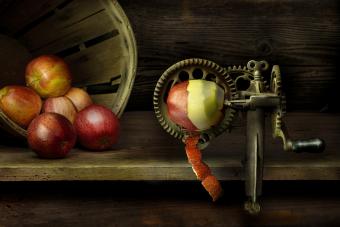
Perched in your family's prided peacock chair, you can just see the basket of fruit on the side table next to your mother's needlework and your school pictures. Only, this is a pile of fruit you can't actually sink your teeth into - unless you want to chip one. Vintage glass fruit is one of those wonderfully dated decorations that sends you right back in time with one glance. If you're lucky, your mother's bowl of glass fruit might just be worth way more than the compliments she got about it back in the 60s.
Vintage Glass Fruit and the Rise of Art Glass

Art glass is hand blown and created for an aesthetic or decorative purpose. These pieces aren't meant to be used in a practical way, but admired for how funky and cool they are. By the 1950s, art glass was gaining popularity. People during the 1960s and 1970s, decades where everyone prided themselves on mixing and matching every color of the rainbow, were big fans of art glass. Probably because of how many vibrant, saturated colors you could get them made in. They also balanced well with the neutral wood furniture that was everywhere at the time.
How to Identify Vintage Glass Fruit

You can tell a piece of glass fruit from plastic or foam using your eyes, but being able to date it is trickier. Unless it's specifically signed by a glass blower or company, then you have nothing really to go on.
However, you can identify if it was hand blown or machine blown, and machine-blown art glass didn't start in earnest until after the 1970s. So, hand-blown glass has a higher chance of being made before the 1980s.
If a piece of art glass is hand blown, it should have most of these characteristics:
- Pontil marks - Pontil marks are the circular scarring you can find somewhere on the glass that indicates it was broken off of the punty rod.
- Imperfections in the glass - If you can see small bubbles trapped inside the glass, or some other imperfection, it was likely hand blown.
- No visible seam lines - Machine-made glass has visible seam lines running throughout the piece where the parts were molded together, but blown glass doesn't have any seams.
- Signatures - It's likely, though not standard, for professional glass blowers to sign their work.
Vintage Murano Glass Fruit: The Only Glass Fruit That Matters

Murano glass is a high-quality art glass that's made in the Murano region of Italy. For hundreds of years, glass blowers and artisans have been passing on their secrets and creating breathtaking pieces that sell for thousands of dollars.
While these artists didn't only make glass fruit, it was one of the many decorative motifs they created in the mid-20th century. If you're not well-versed in telling cheap glass from expensive, then you might not be able to tell the difference between real Murano glass and imitation. And boy did the glass blowers imitate Murano styles in the mid-century.
Unfortunately, Murano glass artists didn't really sign their work until the 1970s, meaning there's a lot of undocumented Murano glass. If your piece looks particularly well-crafted, and maybe bears a sticker saying it comes from Murano, Italy, it's worth having an appraiser look it over.
How Much Is Vintage Glass Fruit Worth?

It probably doesn't surprise you that there's not much demand for fruit made of glass. But that doesn't mean specialty collectors don't grab the best pieces at auction. Because there's no artist hierarchy for this glassware, prices tend to be based on the individual fruit's style, the quality of the glass, and who's interested in buying it.
Values truly run the gamut for vintage glass fruit, spanning anywhere between $10 a piece to the $1,000-$3,000 range for the highest quality sets. For example, this simple stippled glass orange sold for only $8.99 on eBay. Meanwhile, a similarly textured lot of 5 vintage glass fruits from Murano is currently listed for $2,200 on 1st Dibs.
But, based on the average lower prices these collectibles sell for, it won't do to get your hopes up about making a huge profit off of your parents' old glass fruit.
Glass Fruit That Never Fades
Mid-century home décor just loved elevating the mundane. Why else would you find cross-stitched scenes framed on the walls or glass fruit decorating the tables? While this colorful vintage art glass isn't all that valuable, it's well worth keeping around, if only to add a touch of whimsy to your room.







